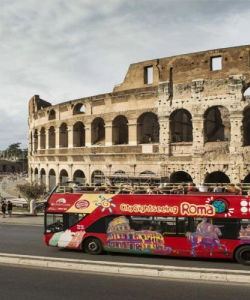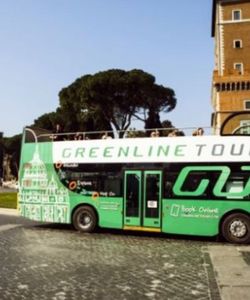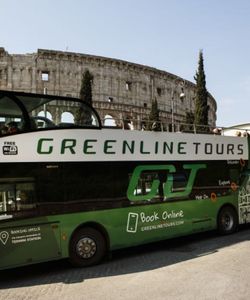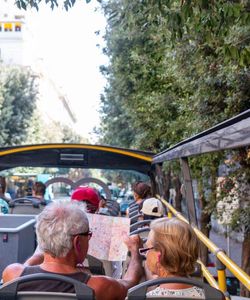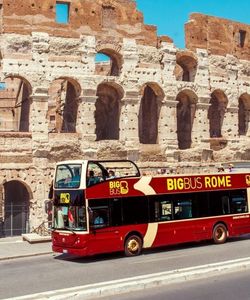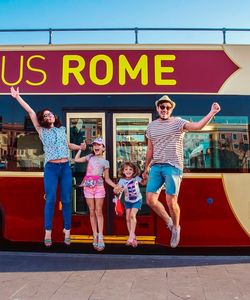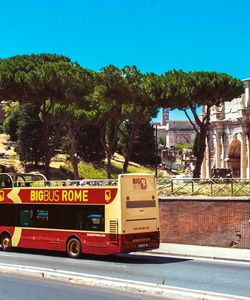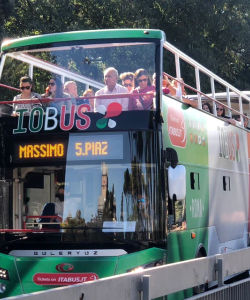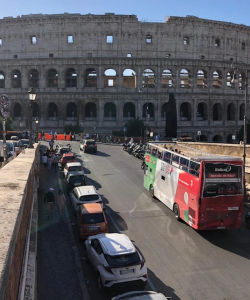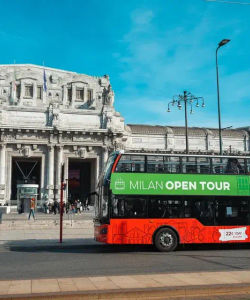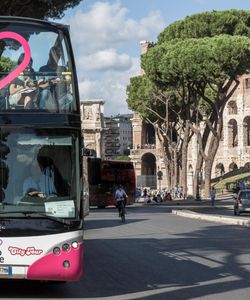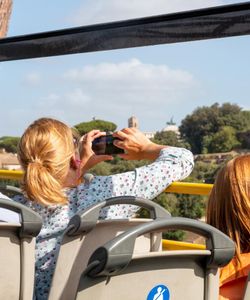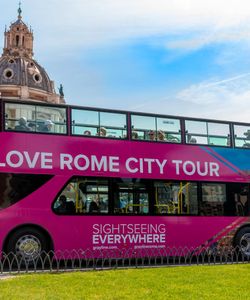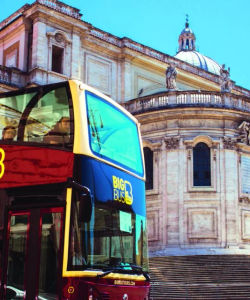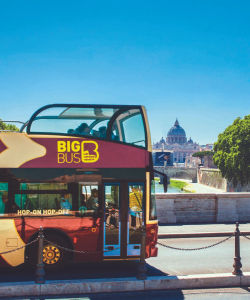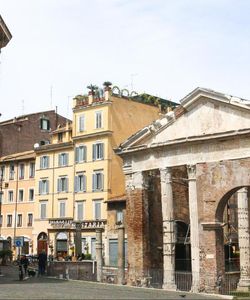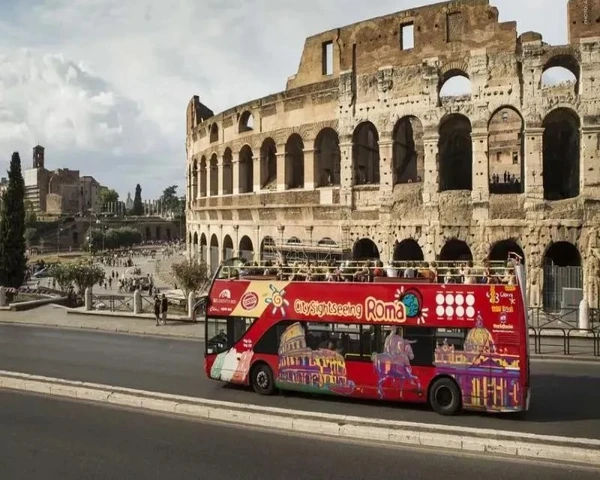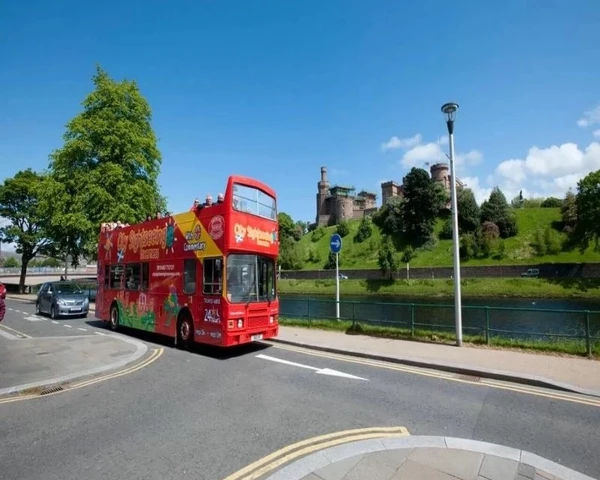Hop On Hop Off Rome Bus Tours
City Sightseeing: Rome Hop-On, Hop-Off Bus Tour
- Unlimited Hop on Hop off from the bus with City Sightseeing Rome buses.
- Rome Hop on Hop off bus tour is available with 4 ticket options 1 Day & 24, 48 or 72 hours.
- You will see the Rome from an entirely different perspective from the open top of double deck buses.
- The Hop On Hop Off Rome bus tour offers an acoustic guide that will keep you informed about the places you visit and their significance.
- Audio guide is available in 8 different languages.
- Smartphone Voucher Accepted! No need to print.
- Unlimited Hop on Hop off from the bus with City Sightseeing Rome buses.
- Rome Hop on Hop off bus tour is available with 4 ticket options 1 Day & 24, 48 or 72 hours.
- You will see the Rome from an entirely different perspective from the open top of double deck buses.
- The Hop On Hop Off Rome bus tour offers an acoustic guide that will keep you informed about the places you visit and their significance.
- Audio guide is available in 8 different languages.
- Smartphone Voucher Accepted! No need to print.
- 1 Day, 24h, 48h or 72h Rome Hop-On Hop-Off Bus Ticket
- Audio commentary in 8 languages: Italian, English, Spanish, Chinese, French, German, Russian, Portuguese
- Free Wi-fi on board
- Assistance on board
- Sightseeing Experience Free App, perfect to know real time position of buses and the waiting time at the stop.
- Audio Guided Historic Walking Tour Included in 5 different languages: English, French, German, Italian and Spanish
- 1 Day, 24h, 48h or 72h Rome Hop-On Hop-Off Bus Ticket
- Audio commentary in 8 languages: Italian, English, Spanish, Chinese, French, German, Russian, Portuguese
- Free Wi-fi on board
- Assistance on board
- Sightseeing Experience Free App, perfect to know real time position of buses and the waiting time at the stop.
- Audio Guided Historic Walking Tour Included in 5 different languages: English, French, German, Italian and Spanish
Free Wi-Fi Onboard: Yes
Facilitated access for disabled people: Yes
Domestic Animals: The access to the bus is permitted for little and medium domestic animals only if they are inoffensive. Using muzzle and leash is mandatory, as alternative to the muzzle it is possible to use a pet carrier. The holder must also assure that the animal doesn’t disturb or damage other passengers or the staff on the bus and that doesnt’ get the bus dirty, the penalty will be the full reimbursement of the damage. The owner or the holder of the animal is liable for the damage caused.
Policy Baggages on board: For safety reasons it is strictly forbidden to bring luggages, awkward bags, big backpacks or builky baggages on board the City Sightseeing buses.
Mobile App: Customers are advised to download the "Sightseeing Experience" app to see the most up to date bus stop locations and timings. It is available in five languages.
Tours operate in all weather, rain or shine. Refunds due to weather will not be granted unless the service is suspended as a result of weather.
Disclaimer: Due to traffic issues, public holidays, weather conditions, cruise ship arrivals and unforeseen circumstances, there might be sudden changes in the route or on the schedule. In "normal times" Rome is a busy city, especially during special events, summer holidays and at weekends. Traffic congestion and road closures - may cause delays, reduced frequency and changes to the route. We’ll do all we can to provide a smooth and frequent service! No refund possible in such conditions.
Free Wi-Fi Onboard: Yes
Facilitated access for disabled people: Yes
Domestic Animals: The access to the bus is permitted for little and medium domestic animals only if they are inoffensive. Using muzzle and leash is mandatory, as alternative to the muzzle it is possible to use a pet carrier. The holder must also assure that the animal doesn’t disturb or damage other passengers or the staff on the bus and that doesnt’ get the bus dirty, the penalty will be the full reimbursement of the damage. The owner or the holder of the animal is liable for the damage caused.
Policy Baggages on board: For safety reasons it is strictly forbidden to bring luggages, awkward bags, big backpacks or builky baggages on board the City Sightseeing buses.
Mobile App: Customers are advised to download the "Sightseeing Experience" app to see the most up to date bus stop locations and timings. It is available in five languages.
Tours operate in all weather, rain or shine. Refunds due to weather will not be granted unless the service is suspended as a result of weather.
Disclaimer: Due to traffic issues, public holidays, weather conditions, cruise ship arrivals and unforeseen circumstances, there might be sudden changes in the route or on the schedule. In "normal times" Rome is a busy city, especially during special events, summer holidays and at weekends. Traffic congestion and road closures - may cause delays, reduced frequency and changes to the route. We’ll do all we can to provide a smooth and frequent service! No refund possible in such conditions.
Green Line Tours: Rome Hop-On, Hop-Off Bus Tour
- Highly Recommended by our mutual customers
- From an open-roof bus, take in panoramic views of this beautiful city.
- If you are in Rome for limited time, you can choose between "3 Pass" or "Daily Ticket"
- With a 24, 48 or 72-hour pass to the hop-on hop-off sightseeing bus, you can visit the sites of Rome at your own leisure.
- See all of Imperial Rome's major landmarks, such as the Colosseum, Forum, and Circus Maximus.
- On the bus, listen to amusing and educational audio commentary in a multiple of languages.
- Depending on your trip intentions, you may select from a variety of ticket alternatives.
- Smartphone Voucher Accepted. No need to print!
- Highly Recommended by our mutual customers
- From an open-roof bus, take in panoramic views of this beautiful city.
- If you are in Rome for limited time, you can choose between "3 Pass" or "Daily Ticket"
- With a 24, 48 or 72-hour pass to the hop-on hop-off sightseeing bus, you can visit the sites of Rome at your own leisure.
- See all of Imperial Rome's major landmarks, such as the Colosseum, Forum, and Circus Maximus.
- On the bus, listen to amusing and educational audio commentary in a multiple of languages.
- Depending on your trip intentions, you may select from a variety of ticket alternatives.
- Smartphone Voucher Accepted. No need to print!
- Rome Double-Decker Bus Pass
- Tickets are valid for 1 Day, 24, 48 or 72-Hours
- Audio Commentary in 16 Languages: Italian, English, Spanish, French, German, Russian, Japanese, Portoghese, Chinese, Korean, Dutch, Arabic, Hindi, Ebraico, Greco, Polacco
- Multilingual hostess on board
- Disposable earphones
- Free Wi-fi on board
- Hop-On, Hop-Off Map of Rome
- Rome Double-Decker Bus Pass
- Tickets are valid for 1 Day, 24, 48 or 72-Hours
- Audio Commentary in 16 Languages: Italian, English, Spanish, French, German, Russian, Japanese, Portoghese, Chinese, Korean, Dutch, Arabic, Hindi, Ebraico, Greco, Polacco
- Multilingual hostess on board
- Disposable earphones
- Free Wi-fi on board
- Hop-On, Hop-Off Map of Rome
Facilitated access for disabled people: Yes
Wheelchair / Stollers Accessible: Yes
Free Wi-Fi: Yes
What to Bring: Passport or ID card for children, Sun Hat, Sun Glasses, Comfortable Shoes
Not Allowed: Oversize luggage, Pets, Smoking, Alcohol and Drugs
Disclaimer: Due to traffic issues, public holidays, weather conditions, cruise ship arrivals and unforeseen circumstances, there might be sudden changes in the route or on the schedule. In "normal times" Rome is a busy city, especially during special events, summer holidays and at weekends. Traffic congestion and road closures - may cause delays, reduced frequency and changes to the route. We’ll do all we can to provide a smooth and frequent service!
TICKETS:
3 PASS TICKET: Ticket with daily validity that allows ascents and descents at 3 stops of your choice.
DAILY TICKET: Ticket with daily validity that allows an unlimited number of ascents and descents at the various stops
24 HOURS TICKET: Ticket valid for 24 hours from the first boarding, which allows an unlimited number of ascents and descents at the various stops.
48 HOURS TICKET: Ticket valid for 48 hours from the first boarding, which allows an unlimited number of ascents and descents at the various stops.
72 HOURS TICKET: Ticket valid for 72 hours from the first boarding, which allows an unlimited number of ascents and descents at the various stops.
Facilitated access for disabled people: Yes
Wheelchair / Stollers Accessible: Yes
Free Wi-Fi: Yes
What to Bring: Passport or ID card for children, Sun Hat, Sun Glasses, Comfortable Shoes
Not Allowed: Oversize luggage, Pets, Smoking, Alcohol and Drugs
Disclaimer: Due to traffic issues, public holidays, weather conditions, cruise ship arrivals and unforeseen circumstances, there might be sudden changes in the route or on the schedule. In "normal times" Rome is a busy city, especially during special events, summer holidays and at weekends. Traffic congestion and road closures - may cause delays, reduced frequency and changes to the route. We’ll do all we can to provide a smooth and frequent service!
TICKETS:
3 PASS TICKET: Ticket with daily validity that allows ascents and descents at 3 stops of your choice.
DAILY TICKET: Ticket with daily validity that allows an unlimited number of ascents and descents at the various stops
24 HOURS TICKET: Ticket valid for 24 hours from the first boarding, which allows an unlimited number of ascents and descents at the various stops.
48 HOURS TICKET: Ticket valid for 48 hours from the first boarding, which allows an unlimited number of ascents and descents at the various stops.
72 HOURS TICKET: Ticket valid for 72 hours from the first boarding, which allows an unlimited number of ascents and descents at the various stops.
No Cancellation Charges up to 24 hours before the chosen travel date. 100% cancellation fee applied within 24 hours of travel date. Ticket is Amendable: If your travel plan change and you need to amend your ticket, kindly inform us at least 3 days before your tour. Changes will only be honoured as long as the voucher has not been used.
Gray Line Rome: Hop-On, Hop-Off Bus Tour
- Witness beautiful Rome at your pace
- Pre-recorded audio commentary and free Wi-Fi onboard
- Learn about Rome’s history with the Hop-on, Hop-off bus tour
- Hop on and hop off at any of the strategically located stops
- Smartphone Voucher Accepted! (No need to print)
- Rome Hop On Hop Off Bus Ticket
- Free on-board wi-fi
- Audio headset guide in 13 languages (Italian, English, French, Spanish, Portuguese, German, Dutch, Russian, Mandarin Chinese, Japanese, Korean, Hindi, Arabic.)
- WalkingTours available from stops 4/5/6: ask our Team on board!
- Detailed route map
- Rome Hop On Hop Off Bus Ticket
- Free on-board wi-fi
- Audio headset guide in 13 languages (Italian, English, French, Spanish, Portuguese, German, Dutch, Russian, Mandarin Chinese, Japanese, Korean, Hindi, Arabic.)
- WalkingTours available from stops 4/5/6: ask our Team on board!
- Detailed route map
On board Wi-Fi: Yes (Please ask bus staff for password)
Half Day ticket: Valid only for the calendar day of travel selected at the time of booking for 4 hours of use from the time of the first stamping.
24-hour ticket: Valid only for the calendar day of travel selected at the time of booking for 24 hours of use from the time of the first stamping.
48-hour ticket: Valid only for the calendar day of travel selected at the time of booking for 48 hours of use from the time of the first stamping.
72-hour ticket: Valid only for the calendar day of travel selected at the time of booking for 72 hours of use from the time of the first stamping.
One Run ticket: Valid only for the calendar day of travel selected at the time of booking for one run only. No hop off.
On board Wi-Fi: Yes (Please ask bus staff for password)
Half Day ticket: Valid only for the calendar day of travel selected at the time of booking for 4 hours of use from the time of the first stamping.
24-hour ticket: Valid only for the calendar day of travel selected at the time of booking for 24 hours of use from the time of the first stamping.
48-hour ticket: Valid only for the calendar day of travel selected at the time of booking for 48 hours of use from the time of the first stamping.
72-hour ticket: Valid only for the calendar day of travel selected at the time of booking for 72 hours of use from the time of the first stamping.
One Run ticket: Valid only for the calendar day of travel selected at the time of booking for one run only. No hop off.
No Cancellation Charges up to 24 hours before the chosen travel date. 100% cancellation fee applied within 24 hours of travel date.
US$ 18.36
Big Bus Tours: Rome Hop-On, Hop-Off Bus Tour
- The "Eternal City" is shown in all its glory on our daytime tour of Rome.
- Unlimited Hop on Hop Off across the city.
- Prerecorded commentary is available in 9 languages.
- Free Wi-Fi and app are available.
- Bus service is available all over the year.
- Smartphone Voucher Accepted! No need to print.
- The "Eternal City" is shown in all its glory on our daytime tour of Rome.
- Unlimited Hop on Hop Off across the city.
- Prerecorded commentary is available in 9 languages.
- Free Wi-Fi and app are available.
- Bus service is available all over the year.
- Smartphone Voucher Accepted! No need to print.
Discover Ticket
- 24-Hour Rome Hop-On, Hop-Off
- Pre-recorded commentary in 9 languages: English, Italian, Spanish, French, German, Brazilian Portuguese, Mandarin, Arabic and Russian.
- VOX City Walk - Digital Guided Walking Tour
- Free Wi-Fi
Essential Ticket
- 48-Hour Rome Hop-On, Hop-Off
- Pre-recorded commentary in 9 languages: English, Italian, Spanish, French, German, Brazilian Portuguese, Mandarin, Arabic and Russian.
- VOX City Walk - Digital Guided Walking Tour
- Free Wi-Fi
Explore Ticket
- 72-Hour Rome Hop-On, Hop-Off
- Pre-recorded commentary in 9 languages: English, Italian, Spanish, French, German, Brazilian Portuguese, Mandarin, Arabic and Russian.
- VOX City Walk - Digital Guided Walking Tour
- 1-hour Panoramic Night Tour (Between 01st June - 30th October)
- Free Wi-Fi
Discover Ticket
- 24-Hour Rome Hop-On, Hop-Off
- Pre-recorded commentary in 9 languages: English, Italian, Spanish, French, German, Brazilian Portuguese, Mandarin, Arabic and Russian.
- VOX City Walk - Digital Guided Walking Tour
- Free Wi-Fi
Essential Ticket
- 48-Hour Rome Hop-On, Hop-Off
- Pre-recorded commentary in 9 languages: English, Italian, Spanish, French, German, Brazilian Portuguese, Mandarin, Arabic and Russian.
- VOX City Walk - Digital Guided Walking Tour
- Free Wi-Fi
Explore Ticket
- 72-Hour Rome Hop-On, Hop-Off
- Pre-recorded commentary in 9 languages: English, Italian, Spanish, French, German, Brazilian Portuguese, Mandarin, Arabic and Russian.
- VOX City Walk - Digital Guided Walking Tour
- 1-hour Panoramic Night Tour (Between 01st June - 30th October)
- Free Wi-Fi
No Cancellation Charges up to 24 hours before the chosen travel date. 100% cancellation fee applied within 24 hours of travel date.
IOBUS: Rome Open-Top Hop-On, Hop-Off Bus Tour
- Unlimited access to Rome Hop-On, Hop-Off bus tour across the city with IOBUS
- From the open top of a double-decker bus, you will see the city from a whole new perspective.
- Multi-lingual recorded commentary is available in 8 languages on-board
- The hue of the bus Italian tricolor
- Using our POP GUIDE APP, guests will be able to enjoy walking tours as they get off the bus.
- The ability to recharge one's phone on the bottom level of all our buses
- On-board Wi-Fi is free
- Smartphone Voucher Accepted (No need to print!)
- Unlimited access to Rome Hop-On, Hop-Off bus tour across the city with IOBUS
- From the open top of a double-decker bus, you will see the city from a whole new perspective.
- Multi-lingual recorded commentary is available in 8 languages on-board
- The hue of the bus Italian tricolor
- Using our POP GUIDE APP, guests will be able to enjoy walking tours as they get off the bus.
- The ability to recharge one's phone on the bottom level of all our buses
- On-board Wi-Fi is free
- Smartphone Voucher Accepted (No need to print!)
- 1 RUN Bus Ticket (Option Based)
- After 2pm Hop-On, Hop-Off Bus Ticket (Option Based)
- 1 Day, 24, 48 & 72 Hours Hop-On, Hop-Off Bus Ticket (Option Based)
- Audio commentary in 8 languages: Italian, English, French, German, Spanish, Russian, Portuguese and Japanese
- Earphones
- Free Wi-Fi on board of each bus
- POP GUIDE App
- Walking routes through APP
- Commentary for children via APP
- Hand sanitizer on board each bus
- 1 RUN Bus Ticket (Option Based)
- After 2pm Hop-On, Hop-Off Bus Ticket (Option Based)
- 1 Day, 24, 48 & 72 Hours Hop-On, Hop-Off Bus Ticket (Option Based)
- Audio commentary in 8 languages: Italian, English, French, German, Spanish, Russian, Portuguese and Japanese
- Earphones
- Free Wi-Fi on board of each bus
- POP GUIDE App
- Walking routes through APP
- Commentary for children via APP
- Hand sanitizer on board each bus
Terminal A: First Bus: 09:00am, Last Bus: 5:30pm First Stop: Via Marsala (Termini Station) Frequency: Every 20-30 minutes Terminal B: First Bus: 09:20am, Last Bus: 5:50pm First Stop: Piazza Dei Cinquecento Frequency: Every 50 minutes
Terminal A: First Bus: 09:00am, Last Bus: 5:30pm First Stop: Via Marsala (Termini Station) Frequency: Every 20-30 minutes Terminal B: First Bus: 09:20am, Last Bus: 5:50pm First Stop: Piazza Dei Cinquecento Frequency: Every 50 minutes
Wheelchair Access: Wheelchair accessibility is available on all buses. Tourists with disabilities and in wheelchairs can board the bus via the external platform and sit on the lower floor in the seat reserved for them
Air-conditioning: Available only on the lower floor of each bus.
Onboard Wi-Fi: No
Pets Allowed: No
Multiday tickets can only be used on consecutive days.
Complimentary ear phones are provided, or you are welcome to use your own wired earphones with a jack connector
Tours operate in all weather, rain or shine. Refunds due to weather will not be granted unless the service is suspended as a result of weather.
Disclaimer: Due to traffic issues, public holidays, weather conditions, cruise ship arrivals and unforeseen circumstances, there might be sudden changes in the route or on the schedule. In "normal times" Rome is a busy city, especially during special events, summer holidays and at weekends. Traffic congestion and road closures - may cause delays, reduced frequency and changes to the route. We’ll do all we can to provide a smooth and frequent service!
Wheelchair Access: Wheelchair accessibility is available on all buses. Tourists with disabilities and in wheelchairs can board the bus via the external platform and sit on the lower floor in the seat reserved for them
Air-conditioning: Available only on the lower floor of each bus.
Onboard Wi-Fi: No
Pets Allowed: No
Multiday tickets can only be used on consecutive days.
Complimentary ear phones are provided, or you are welcome to use your own wired earphones with a jack connector
Tours operate in all weather, rain or shine. Refunds due to weather will not be granted unless the service is suspended as a result of weather.
Disclaimer: Due to traffic issues, public holidays, weather conditions, cruise ship arrivals and unforeseen circumstances, there might be sudden changes in the route or on the schedule. In "normal times" Rome is a busy city, especially during special events, summer holidays and at weekends. Traffic congestion and road closures - may cause delays, reduced frequency and changes to the route. We’ll do all we can to provide a smooth and frequent service!
You can now amend or cancel your ticket for free of charge upto 24 hours before the chosen travel date (During the ticket validity period). 100% cancellation fee applied within 24 hours of travel date. This ticket is non-transferable.
Combo Pass: Milan and Rome Hop On Hop Off Value Pass
- Enjoy the view from open double decker bus
- Enjoy 360º panoramic views of Milan and Rome
- Visit the Gothic architectures and stroll around the historic city park
- Major stops of Rome will be Terminal Via Marsala-Largo di Villa Peretti-Santa Maria Maggiore -Colosseo-Circo Masimo-Piazza Venezia-Vaticano-Piazza di Spagna-Barberini/Fontana di Trevi.
- Major stops of Milan will be La Scala Theatre and Museum, Monumental Complex Cathedral and Terraces, Brera’s Picture Gallery, Cenacle, Triennial, Leonardo3, Leonardo’s Vineyard, Milan World
- Unlimited free Wi-Fi and wheel chair accessible
- Audio guide available in 11 languages
- Mobile Voucher accepted, no need to take the print!
- Enjoy the view from open double decker bus
- Enjoy 360º panoramic views of Milan and Rome
- Visit the Gothic architectures and stroll around the historic city park
- Major stops of Rome will be Terminal Via Marsala-Largo di Villa Peretti-Santa Maria Maggiore -Colosseo-Circo Masimo-Piazza Venezia-Vaticano-Piazza di Spagna-Barberini/Fontana di Trevi.
- Major stops of Milan will be La Scala Theatre and Museum, Monumental Complex Cathedral and Terraces, Brera’s Picture Gallery, Cenacle, Triennial, Leonardo3, Leonardo’s Vineyard, Milan World
- Unlimited free Wi-Fi and wheel chair accessible
- Audio guide available in 11 languages
- Mobile Voucher accepted, no need to take the print!
- 24-Hours Hop-On, Hop-Off Bus Ticket
- Audio commentary in 8 languages: Italian, English, French, German, Spanish, Russian, Portuguese and Japanese
- Earphones
- Free Wi-Fi on board of each bus
- POP GUIDE App
- Walking routes through APP
- Commentary for children via APP
- 24-Hours Milan Open Bus Tour Pass (Valid on Both Routes)
- Audio guide available in 11 languages for adults (Italian, English, French, German, Spanish, Portuguese, Dutch, Russian, Chinese, Japanese, Arabic)
- Audio guide in 3 languages dedicated to children (Italian, English, Spanish)
- On-board staff available to travelers to provide support and advice
- Wi-Fi on board
- USB sockets for smartphone charging
- 24-Hours Hop-On, Hop-Off Bus Ticket
- Audio commentary in 8 languages: Italian, English, French, German, Spanish, Russian, Portuguese and Japanese
- Earphones
- Free Wi-Fi on board of each bus
- POP GUIDE App
- Walking routes through APP
- Commentary for children via APP
- 24-Hours Milan Open Bus Tour Pass (Valid on Both Routes)
- Audio guide available in 11 languages for adults (Italian, English, French, German, Spanish, Portuguese, Dutch, Russian, Chinese, Japanese, Arabic)
- Audio guide in 3 languages dedicated to children (Italian, English, Spanish)
- On-board staff available to travelers to provide support and advice
- Wi-Fi on board
- USB sockets for smartphone charging
Pet Policy: All buses are pet friendly, But only service animals are allowed.
Infants must sit on laps.
Pet Policy: All buses are pet friendly, But only service animals are allowed.
Infants must sit on laps.
US$ 45.36
Vatican & Rome: Hop-On, Hop-Off Bus Tour
- Open top hop-on hop-off Rome tour
- Free Wi-Fi available on board
- Audio guide in 8 languages
- Multilingual staff for hassle-free travel and added convenience
- Smartphone Voucher Accepted! (No need to print)
- 24, 48 or 72-Hours Omnia Vatican Bus Pass
- Access to Big Bus Tours and Citysightseeing Rome Buses
- Multilingual audio guide in 8 languages (English, French, German, Italian, Polish, Portuguese, Russian, Spanish)
- 24, 48 or 72-Hours Omnia Vatican Bus Pass
- Access to Big Bus Tours and Citysightseeing Rome Buses
- Multilingual audio guide in 8 languages (English, French, German, Italian, Polish, Portuguese, Russian, Spanish)
Departures: First Bus: 09:00am, Last Bus: 6:40pm Frequency: Every 15-30 minutes Full Loop: 1 hour, 30 minutes First Departure Stop: Piazza dei Cinquecento, 00185, Rome
Voucher: Mobile and paper vouchers are both accepted at all stops. (We recommend to bring a printed copy)
Wheelchair accessibility: Yes (People with disabilities will be welcomed with attention. Only one wheelchair can be accessed on each vehicle)
The consumption of alcohol and food on board the Open Bus is prohibited
Small dogs and cats are allowed on board upon request
Guide dogs for blind people are allowed on board.
Disclaimer: Due to traffic issues, there might be sudden changes in the route or on the schedule. In "normal times" Rome is a busy city, especially during special events, summer holidays and at weekends. Traffic congestion and road closures -may cause delays, reduced frequency and changes to the route. We’ll do all we can to provide a smooth and frequent service!
Voucher: Mobile and paper vouchers are both accepted at all stops. (We recommend to bring a printed copy)
Wheelchair accessibility: Yes (People with disabilities will be welcomed with attention. Only one wheelchair can be accessed on each vehicle)
The consumption of alcohol and food on board the Open Bus is prohibited
Small dogs and cats are allowed on board upon request
Guide dogs for blind people are allowed on board.
Disclaimer: Due to traffic issues, there might be sudden changes in the route or on the schedule. In "normal times" Rome is a busy city, especially during special events, summer holidays and at weekends. Traffic congestion and road closures -may cause delays, reduced frequency and changes to the route. We’ll do all we can to provide a smooth and frequent service!
No Cancellation Charges up to 48 hours before the chosen travel date. 100% cancellation fee applied within 24 hours of travel date.
US$ 35.64
Gray Line Rome: Hop-On Hop-Off with Ghosts and Mysteries
Guided Walking Tour
- 24-hour hop-on hop-off bus ticket along with 1.5 hours walking tour
- Guided tour to mysteries and ghost stories
- Listen to an audio guide and learn the history of Rome
- Affordable and hassle-free tour
- Smartphone Voucher Accepted! (No need to print)
- Rome Hop On Hop Off Bus Ticket (24 Hours)
- Free on-board wi-fi
- Audio headset guide in 13 languages (Italian, English, French, Spanish, Portuguese, German, Dutch, Russian, Mandarin Chinese, Japanese, Korean, Hindi, Arabic.)
- Walking tour of Rome's Ghosts and Mysteries with a professional guide
- Detailed route map
- Rome Hop On Hop Off Bus Ticket (24 Hours)
- Free on-board wi-fi
- Audio headset guide in 13 languages (Italian, English, French, Spanish, Portuguese, German, Dutch, Russian, Mandarin Chinese, Japanese, Korean, Hindi, Arabic.)
- Walking tour of Rome's Ghosts and Mysteries with a professional guide
- Detailed route map
On board Wi-Fi: Yes (Please ask bus staff for password)
On board Wi-Fi: Yes (Please ask bus staff for password)
No Cancellation Charges up to 24 hours before the chosen travel date. 100% cancellation fee applied within 24 hours of travel date.
US$ 59.40
Big Bus Rome Panoramic Night Bus Tour
- Discover the city's violent past by learning about gladiatorial fighting in antiquity. Admire famous sites like the Colosseum and the Vatican.
- Enjoy the old amphitheater while hearing engrossing tales about the Colosseum.
- Enjoy amazing 360-degree views of the Vatican's beautiful gardens and stunning buildings.
- Smartphone Voucher Accepted! No need to print.
- Discover the city's violent past by learning about gladiatorial fighting in antiquity. Admire famous sites like the Colosseum and the Vatican.
- Enjoy the old amphitheater while hearing engrossing tales about the Colosseum.
- Enjoy amazing 360-degree views of the Vatican's beautiful gardens and stunning buildings.
- Smartphone Voucher Accepted! No need to print.
- 1-Hour Rome Night Bus Tour
- Pre-recorded commentary in 5 languages: English, Italian, Spanish, French and German
- Free Wi-Fi
No Cancellation Charges up to 24 hours before the chosen travel date. 100% cancellation fee applied within 24 hours of travel date.
Gray Line Rome: Hop-On, Hop-Off Bus and Jewish Ghetto
Walking Tour
- Hop-On Hop-Off 24-Hour bus ticket
- Free Wi-Fi facility available
- Detailed route map for convenience
- Walking tour with a professional guide
- Smartphone Voucher Accepted! (No need to print)
- Hop-On Hop-Off Open-top Bus 24-hour Ticket
- Free Wifi on board
- Audio guide in 13 languages on board the Pink Bus (Italian, English, French, Spanish, Portuguese, German, Dutch, Russian, Mandarin Chinese, Japanese, Korean, Hindi, Arabic)
- Detailed Bus route map
- Walking tour of the Jewish Ghetto of Rome with a professional guide
- Hop-On Hop-Off Open-top Bus 24-hour Ticket
- Free Wifi on board
- Audio guide in 13 languages on board the Pink Bus (Italian, English, French, Spanish, Portuguese, German, Dutch, Russian, Mandarin Chinese, Japanese, Korean, Hindi, Arabic)
- Detailed Bus route map
- Walking tour of the Jewish Ghetto of Rome with a professional guide
On board Wi-Fi: Yes (Please ask bus staff for password)
Disclaimer: Due to traffic issues, there might be sudden changes in the route or on the schedule. In "normal times" Rome is a busy city, especially during special events, summer holidays and at weekends. Traffic congestion and road closures -may cause delays, reduced frequency and changes to the route. We’ll do all we can to provide a smooth and frequent service!
On board Wi-Fi: Yes (Please ask bus staff for password)
Disclaimer: Due to traffic issues, there might be sudden changes in the route or on the schedule. In "normal times" Rome is a busy city, especially during special events, summer holidays and at weekends. Traffic congestion and road closures -may cause delays, reduced frequency and changes to the route. We’ll do all we can to provide a smooth and frequent service!
No Cancellation Charges up to 24 hours before the chosen travel date. 100% cancellation fee applied within 24 hours of travel date.
US$ 59.40
Hop On Hop Off Rome Bus Tours



